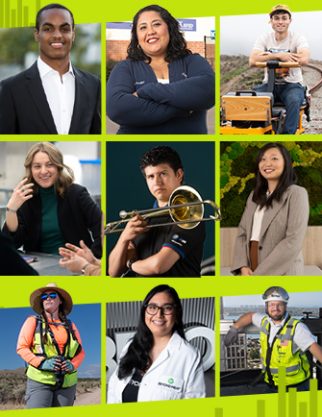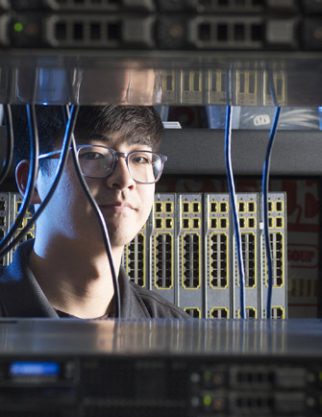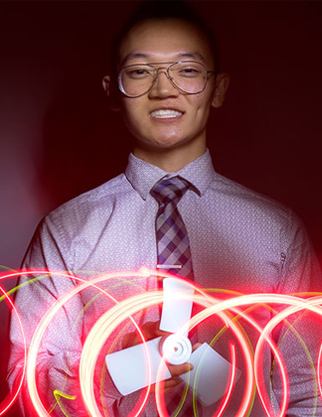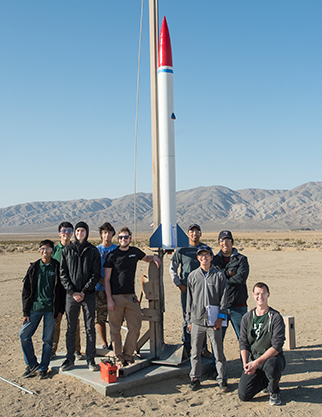Rebecca Plummer now gets to do what she longed for since she first started working with children with disabilities nearly a decade ago.
As a special education teacher, she makes a difference in her students’ lives and uses her voice to ensure they receive what they need to be successful.
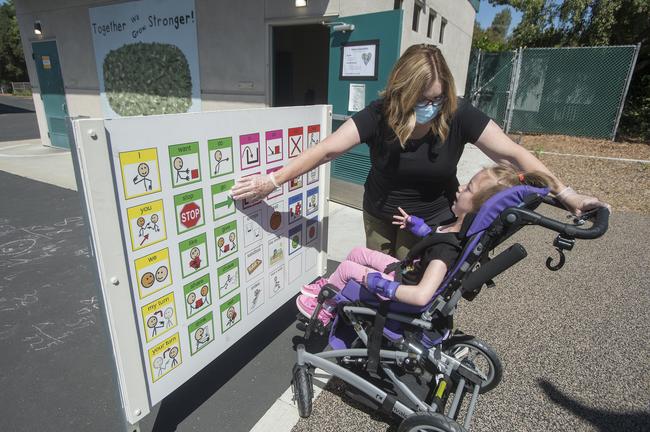 That opportunity was made possible thanks to Cal Poly Pomona’s Special Education of Excellence in Diverse Settings (SEEDS) scholarship, a collaborative program between the College of Education and Integrative Studies and the College of Science that provides grants to future special education and adaptive physical education teachers. California is grappling with a special education teacher shortage statewide, so the grant program is part of Cal Poly Pomona’s way of helping to address this critical need.
That opportunity was made possible thanks to Cal Poly Pomona’s Special Education of Excellence in Diverse Settings (SEEDS) scholarship, a collaborative program between the College of Education and Integrative Studies and the College of Science that provides grants to future special education and adaptive physical education teachers. California is grappling with a special education teacher shortage statewide, so the grant program is part of Cal Poly Pomona’s way of helping to address this critical need.
The road to the classroom has been a winding one for Plummer, who had a long career in the corporate world before she became a special education teacher.
After graduating from Cal Poly Pomona in 1999 with a degree in computer information systems, she started her IT career with the Fortune 500 company, Avery Dennison. But after 15 years on the job, Plummer was ready for a change. She had two young children at home and wanted a third.
“I decided I wanted to be a stay-at-home mom,” she says. “I didn’t want the kids in daycare anymore.”
When her youngest son, now 14, started kindergarten, Plummer felt ready to go back to work, but she didn’t want to return to the long hours and business travel of a corporate job. A friend who worked as a speech therapist for the Claremont Unified School District needed an aide who could work with technology.
It proved to be a perfect fit for Plummer, who helped the speech therapist program tech devices that students with disabilities used for communication and access to learning materials.
“When I started doing that, I fell in love,” she says.
I loved working with the kids. I loved everything about it.
That passion eventually led Plummer to earn a second bachelor’s degree in communication disorders and deaf education through an online program at Utah State University in December 2016 and a certification to become a speech language pathology assistant. Still, she wanted a role that would give her more of a voice where the students were concerned.
She was debating whether to pursue a master’s to become a speech language pathologist or a teaching credential when she happened across an article on Facebook about the SEEDS scholarship.
Planting the SEEDS

Joanne Van Boxtel teaching a student in class.
SEEDS provides for students pursuing a teaching credential in moderate/severe special education and authorization to teach adapted physical education. The program, which trains approximately 60 to 70 students per year, also funds master’s degrees in those two areas of study. In addition to tuition, the scholarship covers books, fees and travel expenses to a conference. The participants meet in cohorts a few times a year for mentoring sessions and professional development workshops and receive assistance in finding teaching positions.
Heather Taylor and Joanne Van Boxtel, professors in the College of Education and Integrative Studies, came up with the idea for SEEDS during a road trip to a conference in Phoenix. Both had taught special education before becoming faculty members and understood the high demand for teachers focused on that particular student population.
In 2017, they received a $1.25 million grant from the federal government to fund the scholarships through 2022. A total of 24 recipients have received scholarships, and six have completed their programs.

Annie Mergenthaler, Amy Lam, Elizabeth Mason and Rebecca Plummer received a scholarship designed to help train special education teachers.
As part of the grant, Taylor, director of SEEDS, and Van Boxtel, co-director, connected with Beth Foster, an associate professor in the Department of Kinesiology and Health Promotion and fellow SEEDS co-director. In addition to increasing the number of special education teachers, the project aims to prepare fully credentialed adapted physical education teachers to teach students with disabilities.
Foster, who taught adapted physical education for eight years in Pennsylvania and consulted with school districts in Texas for four years while earning her doctorate, says it’s important for teachers to understand and be able to apply more specialized skills and instructional strategies related to working with special education students. That knowledge will help them once they are in the field, she adds.
Wanted: Special Education Teachers
California has long had a shortage of highly qualified special education teachers, an issue that became more acute around 2015, Van Boxtel says.
According to the Learning Policy Institute, a Palo Alto-based independent, nonprofit organization that conducts research to improve education policy and practice, more than 1,700 special education teachers hired statewide in 2015-16 were on emergency credentials, which are permits issued to teachers with little or no preparation. A subsequent report by the institute in 2020 found attrition is a huge problem among special education teachers in California. More than one out of five special education teachers quit their jobs between the 2015-16 and 2016-17 school year and that about 66 percent of prospective special education teachers have an emergency permit or credential.
“Attrition of special education teachers is associated with inadequate preparation and professional development, challenging working conditions that include large caseloads, overwhelming workload and compliance obligations, inadequate support, and compensation that is too low to mitigate high costs of living and student debt loads,” researchers wrote in the study.
The lack of retention comes at a time when the number of students who rely on special education services is increasing. One in eight students in California, or 12.8 percent, receive these services, according to the state’s Legislative Analyst Office. That is 800,000 of the state’s nearly 6 million K-12 students, according to state figures.
The struggle to find and retain quality special education teachers is something West Covina Unified School District Director of Special Education Lori Williams knows too well.
Sometimes people go into special education, and they don’t quite understand what goes into it,” she says. “It’s a tough job. It’s very challenging, but it is very rewarding.
About one in eight students in her district (about 1,100 out of 8,557 according to figures the California Longitudinal Pupil Achievement Data System collects and reports to the state) rely on its special education program. Unfortunately, Williams doesn’t recall a time in her 26-year career when there hasn’t been a shortage of special education teachers.
In the past few years, the school district has formed a parent liaison group, hired a consultant coach for teachers and launched a week-long, hands-on session focused on helping teachers handle behavioral issues in the classroom — all to help retain teachers and provide opportunities for preparation and growth.
That extra guidance has been effective, but school districts could always do more to mentor and support teachers, says Williams, who has been with West Covina Unified since 2017.
The rewards are worth any challenges, she adds.
“You get to see lives change,” she says. “You are bringing kids to their fullest potential.”
Seeing the Yeses
One of the best ways to retain teachers is to better prepare them before they take on a classroom of their own, says Taylor, who started her career in general education before making the switch to special education.

Students shoot baskets as they take part in a functional obstacle course at the Motor Development Clinic.
Foster came to Cal Poly Pomona in 2017 and runs the Motor Development Clinic on campus, which provides motor skills instruction to students with disabilities in the community. She emphasizes to the future teachers that we shouldn’t make assumptions about what people with disabilities can do and can’t do.
“We get to see the yeses,” she says. “We get to provide students with disabilities the opportunity to participate in activities that they love. We are the first people saying ‘Yes, you can.’ And we figure out how to make the modification to allow them to achieve what they want to do.”
Van Boxtel, who joined Cal Poly Pomona in 2014, says it’s gratifying to send new teachers in the classroom who have the support and the skills they need to be successful.
“It’s been really fulfilling to get to know our students very well throughout their training and to see them getting into positions,” says Van Boxtel, who previously taught special education and mentored teachers. “We’ve had some outstanding students. They are motivated, passionate and skilled with a strong sense of advocacy.”
Finding Purpose
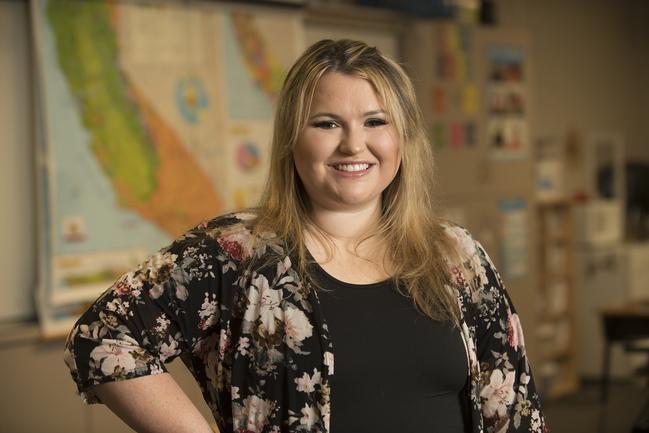 For Elizabeth Mason (’16, organizational communications; ’20, teaching credential), SEEDS and the opportunities that came with it helped her feel more comfortable and knowledgeable during her recently completed first year at Evergreen Elementary School in Walnut.
For Elizabeth Mason (’16, organizational communications; ’20, teaching credential), SEEDS and the opportunities that came with it helped her feel more comfortable and knowledgeable during her recently completed first year at Evergreen Elementary School in Walnut.
Mason, who teaches third- through fifth-grade students with Autism spectrum-related disorders, not only had to face the jitters of taking on her first full-time teaching post but she also had to teach remotely and help students at varying academic levels.
“It’s been a great year,” she says. “There was definitely a learning curve. All the assignments had to be online because of distance learning. It was a lot of 15-hour days where I was prepping to find lessons for individual students.”
Mason worked in insurance after graduating from Cal Poly Pomona in 2016 but felt a sense of dissatisfaction every day. During her senior year of college, she had become interested in teaching.
That interest never left, so after quitting her job, she pursued a teaching credential and learned about the SEEDS scholarship.
“It’s been invaluable, and the best part is that it encouraged me to go directly into getting my master’s degree,” says Mason, who will earn her graduate degree in spring 2022.
While earning her credential and working as an instructional aide, Mason found a lot of fulfillment in working with students with autism. She feels excited to continue that work at Evergreen after completing her credential.
“I like the small victories,” Mason says. “For special education, sometimes it requires a lot of repetition. While the students might not learn at the same pace as others, once it really clicks, you see them grow and it makes it special.”
Plummer, who also will complete her master’s degree in spring 2022 through SEEDS, just finished her third year of teaching. She’s taught students with autism in all elementary grade levels and currently focuses on those with orthopedic and other health impairments at Sumner Danbury Elementary School in Claremont. It is the same school where she started out as an aide. All of her students also are minimally verbal and use some sort of assistive technology, or speech generative device, to communicate and/or access the curriculum.
It was a little nerve-wracking to teach remotely with the parents having to assist from home, but Plummer’s students returned to the classroom in April. And she continues to fuel that spark that made her want to teach: A longing to make a difference.
“That’s part of the reason I left my corporate job. I loved the work, but I didn’t feel that it was really meaningful. I didn’t think it mattered. I had lost one of my best friends around that same time who had passed from cancer.
“After seeing what she went through and the nurses, I wanted to do something that had more meaning in life. When I started working with these kids, I felt that need was fulfilled.”
